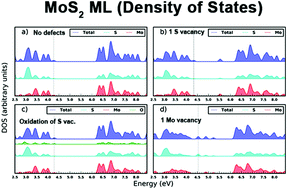A systematic study of various 2D materials in the light of defect formation and oxidation†
Abstract
The thermodynamic aspects of various 2D materials are explored using Density Functional Theory (DFT). Various metal chalcogenides (MX2, M = metal, chalcogen X = S, Se, Te) are investigated with respect to their interaction and stability under different ambient conditions met in the integration process of a transistor device. Their interaction with high-κ dielectrics is also addressed, in order to assess their possible integration in Complementary Metal Oxide Semiconductor (CMOS) field effect transistors. 2D materials show promise for high performance nanoelectronic devices, but the presence of defects (vacancies, grain boundaries,…) can significantly impact their electronic properties. To assess the impact of defects, their enthalpies of formation and their signature levels in the density of states have been studied. We find, consistently with literature reports, that chalcogen vacancies are the most likely source of defects. It is shown that while pristine 2D materials are in general stable whenever set in contact with different ambient atmospheres, the presence of defective sites affects the electronic properties of the 2D materials to varying degrees. We observe that all the 2D materials studied in the present work show strong reactivity towards radical oxygen plasma treatments while reactivity towards other common gas phase chemical such as O2 and H2O and groups present at the high-κ surface varies significantly between species. While energy band-gaps, effective masses and contact resistivities are key criteria in selection of 2D materials for scaled CMOS and tunneling based devices, the phase and ambient stabilities might also play a very important role in the development of reliable nanoelectronic applications.

- This article is part of the themed collection: 2018 PCCP HOT Articles


 Please wait while we load your content...
Please wait while we load your content...